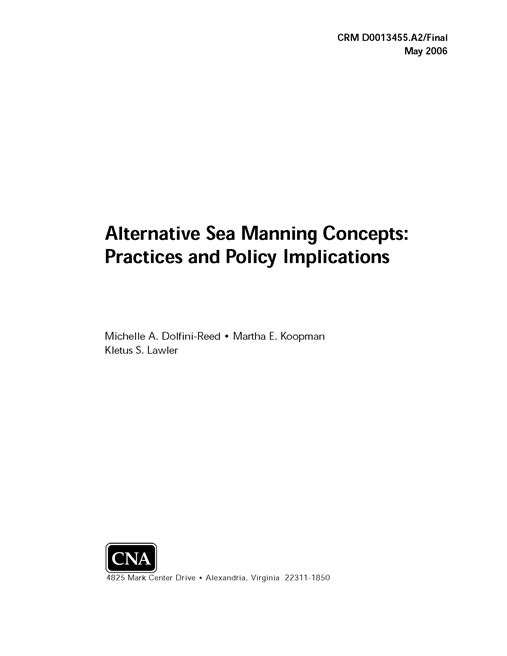In this paper, we examine the recent inventory of alternative sea man - ning initiatives and experiments that the Navy has been exploring. The initiatives fall under the broad categories of (1) rotational crewing and (2) extra manning pools and optimal manning.
Rotational crewing
Rotational crewing initiatives invo lve the optimal rotation of person - nel to and from forward-deployed Navy ships and submarines. The primary advantage of rotational crewing is the ability that this approach gives the Navy to maximize the fleet's forward presence while adhering to the Navy's personnel tempo (PERSTEMPO) rules. The Navy has used three approaches to rotational crewing:
- Blue-Gold, in which two crews are assigned to a single ship
- Horizon, which involves the use of multiple crews to support fewer ships ( more crews than hulls)
- Sea Swap, which uses the same number of crews as ships.
Rotational crewing designs are not entirely compatible with the Navy’s newly institutionalized deployment strategy, the Fleet Response Plan (FRP). Rotational crewing emphasizes continuous forward presence, while the FRP and fleet deployment cycle emphasize presence with a purpose and surge capability. Nonetheless, the Navy is finding an operational niche for ships manned using rotational crewing, as proven by the use of PCs, MCM-1s, and MHCs forward deployed to the Persian Gulf. These ships provide a steady, low-level background presence that supplemen ts carrier strike groups CSGs and expeditionary strike groups (ESGs). A number of issues, however, present concerns:
- The cost of rotational crewing in terms of finding offsetting shore billets to cut
- Potential impact on sea-shore ratios
- Balancing schoolhouse and shipboard training schedules, particularly under high operating tempos
- The intensity of work for both onstation and homeport crews
- The impact on Sailor retention and attrtion.
We found that reenlistment rates for crews participating in the first Sea Swap provide a mixed picture. Crew reenlistment rates were lower for the DD Sea Swap crews than comparison DD crews and virtually the same between DDG Sea Swap crews and comparison DDG crews. The reenlistment rates for the DDG crews may be more reflective of crew responses to Sea Swap since the DD crews were also decommissioning their original ships and being reassigned to new billets following the end of their deployments. The descriptive patterns for the DDGs suggest that overall Sea Swap had little impact on crew reenlistments over the longer term; however, it will be essential that the Navy monitor retention tren ds with any rotational crewing application or any major change in sea or shore duty attributes.
Download reportApproved for Public Release; Distribution Unlimited. Specific authority: N00014-05-D-0500.
Details
- Pages: 76
- Document Number: CRM D0013455.A2/Final
- Publication Date: 5/1/2006
